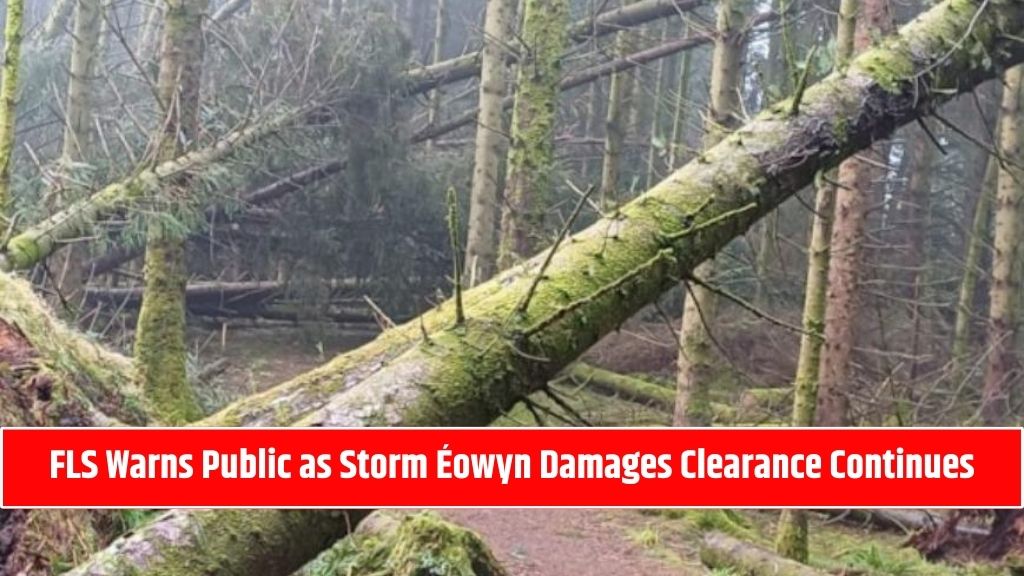Storm Éowyn recently brought extreme weather conditions to the Borders, with winds reaching up to 90mph and a rare red weather warning issued across the region. The aftermath of the storm left forests damaged, paths blocked, and significant clean-up efforts underway. Forestry and Land Scotland (FLS) is urging the public to stay cautious and follow safety guidelines while the recovery work continues.
Public Safety Comes First: FLS Issues Warning
The severe storm caused extensive damage across forests in the Borders, with fallen trees and unstable ground posing significant risks. Martin Page, the visitor services manager for FLS’s south region, has requested patience from the public.
“We appreciate that this will cause some inconvenience, but public safety – as well as the safety of our staff – is paramount.”
Page emphasized the importance of giving work crews the space and time needed to clear debris safely. The public is advised to visit the FLS website for updates on accessible trails and the progress of the clean-up operation.
Key Safety Guidelines for Visitors
FLS has outlined several important safety measures for anyone visiting forested areas in the region:
- Obey Safety Signage
Always follow posted signs and warnings. These indicators are placed to protect both visitors and workers. - Avoid Blocked Trails
If a path is blocked, turn back immediately. Do not attempt to go around or cross over felled trees. - Stay Clear of Work Zones
Work areas are particularly dangerous due to ongoing tree removal and equipment use. - Beware of Unstable Trees
Storm-felled, hanging, and even standing trees can be unstable and may shift or fall unexpectedly.
The Hidden Dangers of Storm Damage
Storm damage in forests is often deceptive. Trees that appear intact can be under immense tension, making them prone to sudden movements. Even standing trees might pivot, slide, or fall due to hidden structural weaknesses caused by high winds.
Experts warn that only trained professionals should assess and clear these dangers, as the forces involved can be unpredictable and dangerous. The clearing process is slow but essential to ensuring long-term safety in the affected areas.
Significant Damage Across Key Sites
1. Glentress Forest
Glentress Forest, home to a recently opened £18 million holiday complex, experienced severe damage. Cabins were damaged, and trails were obstructed by fallen trees. The clean-up efforts are ongoing, with safety remaining a top priority for both visitors and staff.
2. Dawyck Botanic Garden
More than 50 trees were lost at Dawyck Botanic Garden, disrupting the landscape and leaving behind hazardous conditions. A team from Glendale Services, a landscaping company based in Bolton and Milton Keynes, has been assisting with the clean-up.
One particularly challenging task was the removal of a tilia tree entangled in three beech trees, requiring precise and careful work to prevent further damage.
The Long Road to Recovery
Experts estimate that the clean-up across the Borders could take months to complete. The combination of large tree losses, complex removals, and the need for thorough safety assessments makes the process time-consuming.
FLS teams are working tirelessly to restore safe access to popular walking and cycling trails. However, until their work is finished, visitors are strongly encouraged to stay updated through the FLS website and avoid closed areas.
Storm Éowyn has left a significant mark on the Borders, with high winds causing widespread damage across forests and gardens. While the disruption is inconvenient, public safety must remain the top priority. By following FLS’s guidelines, staying informed about trail closures, and exercising caution, residents and visitors can help ensure that the recovery process proceeds without incident.
| Visit for More News and Updates | WSOA NEWS |
